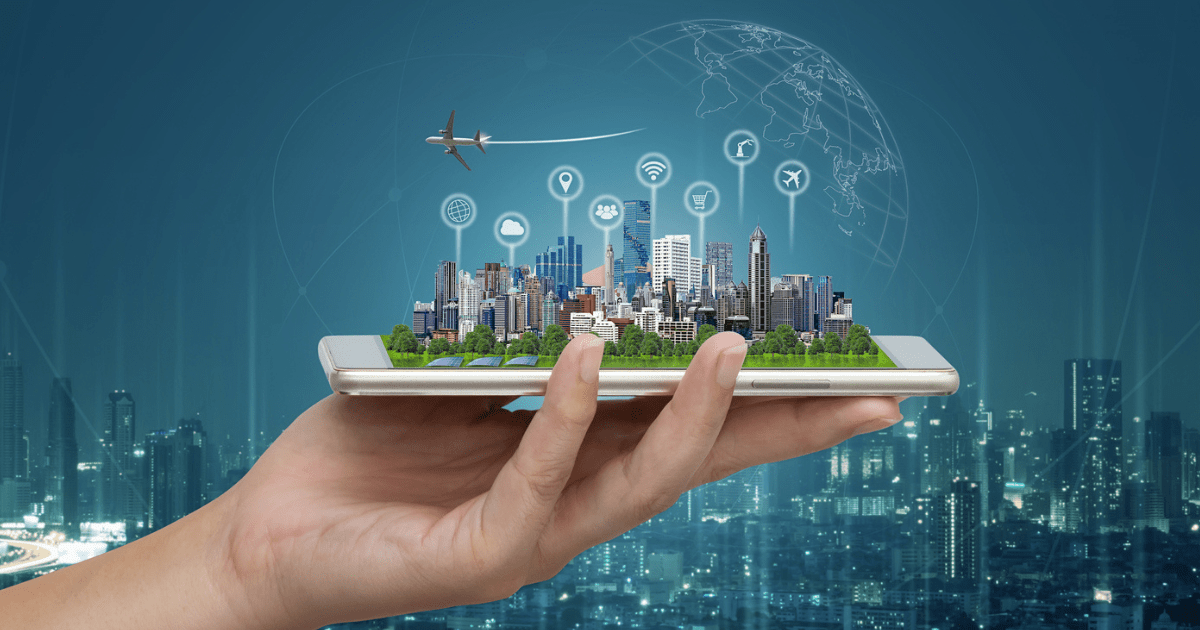What are Smart Cities and how Society can Benefit from it?

Technological advances have allowed us to begin developing Smart Cities, a path to a more sustainable and resource-saving future.
What is a Smart City?
A smart city is an urban area that uses a variety of electronic methods and sensors to collect data. The information derived from this data is used to effectively manage assets, resources and services; In turn, this data is used to improve operations across the city.
How do Smart Cities work?
A smart city uses data and technology for urban development.
Why are more and more cities around the world investing in smart city technology? The United Nations predicts that by 2050, most of the world's population will live in urban areas. Of course, this poses growing ecological, social and economic challenges. Smart city technologies can help address some of these challenges and make cities more liveable.
So, what kind of technology helps to make a smart city “smarter”?
Here are some examples that smart cities depend on:
Internet of Things (IoT) - The Internet of Things is a network of physically connected devices that "talk" to each other by exchanging data. IoT connects technology to smart cities. IoT devices include sensors, lights, and gauges that collect and analyze data.
Sensors - electronic, infrared, thermal, and proximity sensors collect electronic signals and are interpreted by humans or artificial intelligence. Smart cities can have sensors installed to monitor energy consumption, lighting, traffic, weather, and more.
Artificial Intelligence (AI) - Artificial intelligence is a simulation of machines designed to mimic human decision-making. For example, AI can count vehicles, pedestrians or other movements and track their speed. AI can detect faces, read license plates and process all the satellite data to build the models needed for urban planning.
Augmented Reality (AR) - AR allows you to see your real environment with digital augmentation on it. AR technology can improve smart cities in several ways, including disaster management and disaster preparedness. For example, AR can provide information on where you can find nearby events, restaurants, retail stores, hotels, parking lots, or transportation hubs.
What are the Main Advantages of a Smart City?
There are many benefits associated with implementing smart city technologies and learning about these technologies will help you weigh the pros and cons.
Better transportation services: A smart city has the potential to significantly improve the level of transport available across the city. The country will have the ability to better manage traffic, track public transportation and better serve its citizens with consistent information and lower prices.
Efficient Public Services: With limited amounts of natural resources left to meet people's needs, smart cities will have the technologies and necessary tools to reduce our consumption of those resources and reduce waste of water, electricity, etc without subtracting any factor.
Reduced environmental footprint: Smart cities have thousands of energy-efficient buildings that can improve air quality, use renewable energy sources, and reduce reliance on non-renewable energy sources. This helps reduce the environmental impact we have on the environment.
Greater digital justice: People should have access to high-speed internet services at affordable prices and devices. All residents will have equal opportunities to access public Wi-Fi in local areas of the city.
Economic Development Opportunities: Investing in smart cities will improve regional and global competitiveness, attract new residents and boost business. Because the whole city has access to open data platforms, information and more. Your business will flourish. With available technology, they can make informed decisions and lead to economic development.
Infrastructure Improvement: Old roads, buildings, highways and bridges require significant investment to maintain their condition and extend their lifespan. But with the help of smart technology, cities can predict and analytically identify potential areas of infrastructure failure before it happens.
Jobs: A smart city will provide many business and employment opportunities, as people have equal access to basic resources such as transportation, internet connection, and job opportunities.
Reduction of crime: With the help of technology, authorities can closely monitor people's interactions, reducing crime rates. What's more, when jobs go down and unemployment rises, crime goes up. However, as employment opportunities increase, so will crime.
Why should Governments invest in Smart Cities?
Government leaders, citizens and business professionals understand that today's infrastructure requires significant reinvestment and modernization. As seen most clearly in cities, these needs typically exceed municipal capacity to fund them. This situation creates the need for municipalities to calculate, with the least margin of error, the cost/benefit ratio of investing in a particular technology or idea, as well as developing new ways of investing and financing these infrastructural programs.
Government financial management plays a key role in enabling cities to reinvest and renew, using tax policies, public-private partnerships (PPPs) and performance-based revenue models as key tools of economically effective capital that create long-term value for citizens. It can promote investment for businesses and the whole city.
As infrastructure assets age and deteriorate, the security of citizens and businesses is at risk, as well as the overall economic well-being and global competitiveness of cities and countries.
Initiating a large-scale program of reinvestment and modernization of smart cities will help reduce costs, maximize income potential and improve citizen well-being through the creation of greener, more resilient, high-tech infrastructure.
-min.png?width=1200&height=630&name=New%20Project%20(11)-min.png)
Are they more Sustainable?
The terms, ‘smart cities,’ and ‘sustainability’ often come intertwined; Smart urban planning includes the implementation of environmentally friendly projects that improve the quality of life in society while respecting the environment. Smart cities can use information and communication technology to collect data, optimize operations and improve management so that cities can respond to specific problems and provide solutions. From recycling waste into compost to treating wastewater for construction or cleaning purposes, there are many ways smart cities can promote sustainability.
What qualifies a Smart City to be Sustainable?
Eco-cities or sustainable cities are distinguished by features such as smart management, mobility, green housing and smart economy. A smart city can claim to be sustainable when it comes to improving city services and using technology to address a city's economic, social and environmental challenges while reducing costs.
Benefits of a Sustainable Smart City
With global warming, the greenhouse effect and increasing marine waste, smart cities are finding ways to reduce their CO2 footprint and providing an alternative to reducing the ecological impact of cities. From building energy-efficient buildings and implementing smart waste management systems to realizing renewable energy, reducing carbon footprint has become a major driver.
Below are a few examples of how Smart Cities are a sustainable option:
Energy savings
Smart street lighting can deliver significant energy savings to cities, as they require less energy to operate. LED lighting, for example, lasts a long time and consume less energy.
Reduced air pollution
Smart cities are designed with walkable areas and bike-friendly roads. Efficient public transport, pedestrian zones and ride-sharing services mean fewer cars on the streets. This helps to significantly reduce pollution from vehicles and motor vehicles.
Improved air quality
Smart cities can use air quality sensors to judge air quality and identify sources of pollution. By sending relevant data to the person in charge, they can take appropriate action to improve the city's air quality.
Prevention of infrastructure failures
Smart sensors can provide data that indicate changes in smart city buildings. City tours can use predictive analytics to identify areas that need inspection and maintenance to avoid infrastructure failures and costly repairs.
Enhanced security
Safety is a priority for all cities. Surveillance cameras equipped with facial recognition, motion and smoke detectors and fire alarms allow municipalities to better monitor the safety of their citizens.
Optimised mobility
Smart cities can use smart technologies to reduce traffic congestion and provide citizens with real-time updates, enabling them to better navigate the streets so that goods, services and people can be transported efficiently.
-min.png?width=1200&height=630&name=New%20Project%20(10)-min.png)
What are the Challenges of Smart Cities
Smart cities use intelligent technologies, data analytics, and information and communication technologies (ICT) to ensure operational efficiencies in areas such as government, transport, commerce, energy, law enforcement, and healthcare. Given the scale of such operations, it is inevitable that smart cities will face challenges.
Challenges that every Smart City project encounters:
-
Lack of Suitable Infrastructure for Smart Cities
Smart city initiatives require physical infrastructure and information technology support. Smart technologies should be applied as widely as possible in different sectors such as public transport, energy and power generation. Otherwise, these technologies will not transition well enough to make cities 'smart'.
Physical infrastructure can be provided in the form of camera columns and terminals that citizens interact with. Likewise, the IT infrastructure must be effective and efficient in processing and analyzing the data collected in the aforementioned areas.
Both infrastructures must be scalable to accommodate the growth of smart cities, their populations, and exponentially increasing amounts of data. Also, the infrastructure should be flexible and able to accommodate a wide range of technologies and software.
Smart initiatives and their technology must be sustainable and suitable for long-term operation. Changing infrastructure every few years to adapt to new technologies and growing demands is impractical.
Building robust and efficient infrastructure can increase the price and cost of smart city initiatives. Therefore, budget shortages can also be a problem for smart city initiatives.
-
Transparency and Data Privacy
Smart cities depend on collecting and analyzing data from various sources. The problem is, unless you take the right steps, much of the data can cause privacy issues. You must ask yourself: Where is this information stored? What security measures have been and are being implemented to ensure that this data is not maliciously used or disclosed? For example, personal information and medical records are acquired and stored for medical purposes. Facial recognition can be used to track people and law enforcement, especially in countries where the rule of law is weak.
Citizens and residents of smart cities have the right to be transparent about the use of their information. You also have the right to privacy. Fortunately, some countries are already trying to solve these problems.
For example, the European Union has adopted the General Data Protection Regulation (GDPR), which regulates the use of facial recognition software. Likewise, the state of California has the California Consumer Privacy Act, which restricts the use of consumer information by third parties.
Fear of hackers, data breaches, government and private investigations into data collection, insufficient transparency and public trust can seriously hamper smart city initiatives and projects
-min.png?width=1200&height=630&name=New%20Project%20(12)-min.png)
-
Coordination Between Public and Private Sectors
Data is collected from both the public and private sectors. It is not easy to draw a line between what information should be shared between the two. Data sharing is necessary for the proper functioning of certain functions, services and data controls. Nonetheless creating seamless communication between citizens and private entities can be complicated.
First, the two don't always agree. There is a reluctance to share infrastructure and standardize networks and equipment between the public and private sectors. Personal interests tend to take precedence over public interests.
The best way to achieve data sharing is to find ways to convince each department that they will both benefit from the collaboration rather than keeping certain information to themselves. After all, smart cities depend on good relations and coordination between the government and the private sector to create effective and sustainable programs.
-
Lack of Capacity To Implement Smart City Initiatives
Trying to implement smart city initiatives is one thing, and being able to do so is other. Capacity issues can arise from one or more funding, data processing capacity and efficiency, and energy.
-
Financial Reasons
Maintaining a smart city requires many resources. More specifically, it requires the implementation, operation, and maintenance of smart technologies. The physical and IT infrastructure of the above technologies; Work, experience and expertise of qualified professionals; And of course budget to cover the above costs.
Not all cities have the financial capacity to develop smart city initiatives. Finding multiple stakeholders and sources of public and private funding is a difficult task. City officials and planners need to demonstrate to stakeholders and potential investors that the short- and long-term benefits of smart city initiatives far outweigh the significant costs associated with them.
-
Capacity for Efficient Data Processing
In addition to financial capacity, smart cities require a reliable and efficient way to process and analyse large amounts of data. These come from a variety of sources, such as cameras and other sensors that measure information in real time.
For example, a city may need information to detect high traffic areas, monitor traffic rush hours, traffic volumes, traffic route changes, and so on. There are hundreds, if not thousands, of sensors covering large urban traffic networks. This is already a lot of data for traffic and transportation alone.
In a smart city, many jobs and services are offered. All this requires sensors and their systems, as well as data collection, processing and analysis.
-
Energy Availability
Sensors and cameras are not the only technology used in smart cities. Smart technology relies on power to act. It is important to consider questions such as:
- Are the city's energy sources sufficient to support all of this?
- Are there alternative energy sources to power these technologies in the event of a power failure?
- Is the smart city powered by sun, wind or hydroelectricity? Or does everything work on a diesel generator?
- What systems and technologies are most likely to use alternative energy sources, and which ones can be omitted?
- A smart city cannot simply shut down or pause in the event of a power outage.
-min-1.png?width=1200&height=630&name=New%20Project%20(13)-min-1.png)
-
Political Issues
It is difficult to obtain funds for smart city projects. Many of these programs and projects are usually linked to lobbies and to political interests and will. Politicians may have divergent views on smart city initiatives. If they decide to fund such initiatives themselves, that financial source may run out at the end of their term.
In addition to government funding, smart cities will require funding from multiple stakeholders at the local and national levels, as well as from the private sector. This is complicated by the dynamics of different politicians.
For example, during smart city initiatives, political capital may expire at the end of each political cycle. A handover process to the next batch of government officials will scrutinize smart city initiatives. This extra control can delay work or even completely disrupt certain projects.
Politicians, government agencies, stakeholders, private sector agencies and city planners need to work together. They need to work together to create long-term sustainable initiatives that span different jurisdictions.
-
Mindset of Residents
Projects such as building supporting infrastructure, raising funds, coordinating with government and private agencies, and installing and maintaining smart city technologies take up a lot of time, budget, and resources. However, these alone will not be enough to support the smart city initiative.
Leading smart city initiatives need to take into account the needs of the industry that matter most – smart city residents themselves. Few people are willing to wait that long to see results, especially when taxpayer money is used to fund a smart city project. In addition, the provision, installation and maintenance of the above initiatives can disrupt the lives of residents.
For example, building infrastructure can cause traffic jams, and system upgrades or installations can delay public services and government transactions. These disruptions can easily frustrate citizens and discourage them from supporting the smart city plan.
When planning smart city projects, planners must consider and implement multi-stage strategies. In this way, short-term results can satisfy both residents and stakeholders while contributing to long-term goals.
-
Scarce Information on the Technologies used
When the Smart City initiative is implemented, the government should try to inform the city's residents. After all, what kind of initiative is good for those who can benefit more?
Physical ads, bulletins and face-to-face meetings aren't the only way to do this. Governments should use social media and the Internet in general to disseminate information not only to citizens but also to those who can benefit from new and existing initiatives.
People should know exactly about these initiatives and how they can benefit from them. Town planners and city officials can also post information about these before their release. Information about new, current and future smart city plans should be easily accessible for city dwellers.
Again, social media and the internet can be used to assess how the initiative is working and what changes and improvements can be made. It can also be used to gather information about public opinion regarding future projects that may be implemented.
-
Residents’ Lack of Tech Savvyness
The next hurdle for smart city planners is the general technical skill level of smart city residents. Are their skills sufficient to effectively utilize or benefit from the benefits of these initiatives? Fortunately, training programs can be implemented to solve this problem.
The transition to new ways of working can be accelerated by getting the right education through face-to-face meetings with government officials, physical print, and education accessible through the internet and social media.
-
Social Inclusion Initiatives
Planning for smart city initiatives doesn't have to happen in a vacuum. This needs to be taken into account by all sectors of society, including the most marginalized groups, when the changes brought about by the implementation of smart city initiatives arise. Smart city initiatives should benefit everyone, not just the privileged few.
-
Social and Economic Separation
Smart cities do not necessarily bridge the socio-economic gap caused by factors such as class, race and gender. For example, if a city has already implemented public initiatives, it should undertake the subsequent actions for the implementation of such initiatives.
Likewise, rich and powerful citizens can use their influence to eliminate “undesirables” from their concept of an ideal smart city. Therefore, any smart city initiative must carefully consider how marginalized people can thrive, not just survive, in a society that has historically ignored or rejected them.
Examples of Smart Cities
Cities around the world are at different stages of developing and applying smart technologies. However, there are many ahead of the curve, paving the way for fully smart cities. These include:
- Barcelona, Spain
- Columbus, Ohio, USA
- Dubai, United Arab Emirates
- Hong Kong, China
- Kansas City, Missouri, USA
- London, England
- Melbourne, Australia
- New York City, New York, USA
- Reykjavik, Iceland
- San Diego, California, USA
- Singapore
- Tokyo, Japan
- Toronto, Canada
- Vienna, Austria
Singapore's city-state is considered one of the leaders in the race to create a completely smart city using IoT cameras that monitor the cleanliness of public places, the density of crowds and the movement of registered vehicles. Singapore also has real-time monitoring systems for energy consumption, waste management and water consumption. Additionally, there are self-driving car testing and monitoring systems to ensure the health and well-being of the elderly.
Elsewhere, Kansas City has introduced smart streetlights, interactive kiosks, and more than 50 buildings with free Wi-Fi. Details of parking spaces, traffic flow measurements and pedestrian hotspots are also available to residents via the city data visualization app.
Meanwhile, San Diego has installed 3,200 smart sensors to optimize traffic flow and parking, and increase public safety and environmental awareness. The electric vehicle is powered by a solar charging station, and connected cameras monitor traffic problems and crime.
There are also traffic monitoring systems in Dubai, offering smart telemedicine and healthcare solutions as well as smart buildings, utilities, education and tourism options. Barcelona also has smart transport systems with bus stops offering free Wi-Fi and USB charging ports, as well as a bike-sharing program and a smart parking app with online payment options. Temperature, pollution and noise are also measured using sensors that also cover humidity and rainfall.
Conclusions
Futurists have always envisioned smart cities of the future where residents and visitors thrive. Coordinated and smoothly operated, these modern urban environments are filled with advanced multimodal transportation systems, autonomous power grids, clean and safe neighborhoods, integrated services and meaningful amenities.
Although progress has been made towards a bright future, cities and communities continue to face complex challenges including infrastructure maintenance, population growth and migration, and sustainability issues.
From schools to businesses and from transportation to energy, a holistic vision helps find solutions for every aspect of urban life. By working together, new ideas and new technologies can be concretely implemented to improve the lives of citizens and create a better future.


